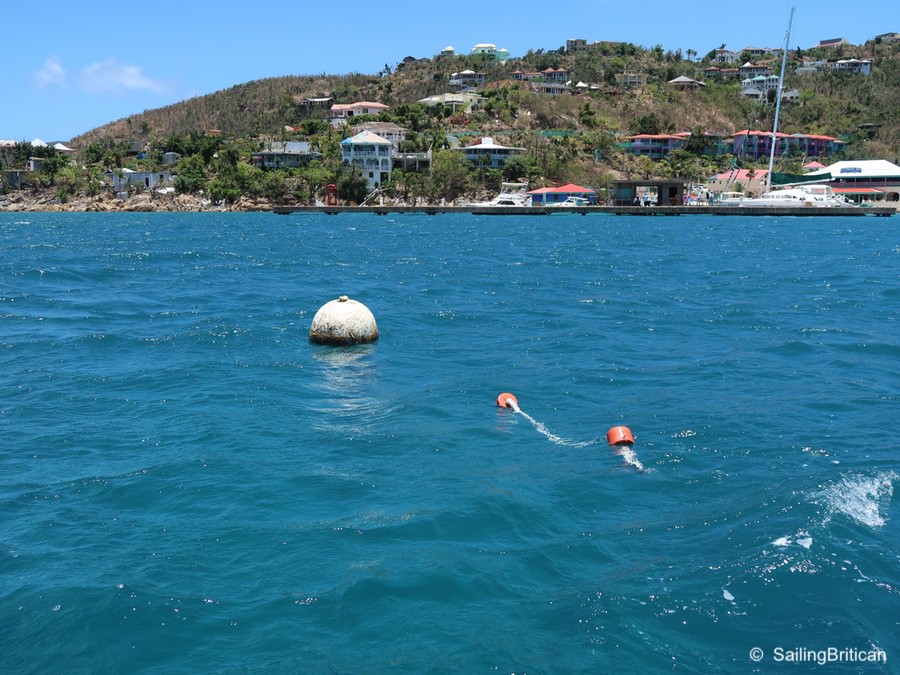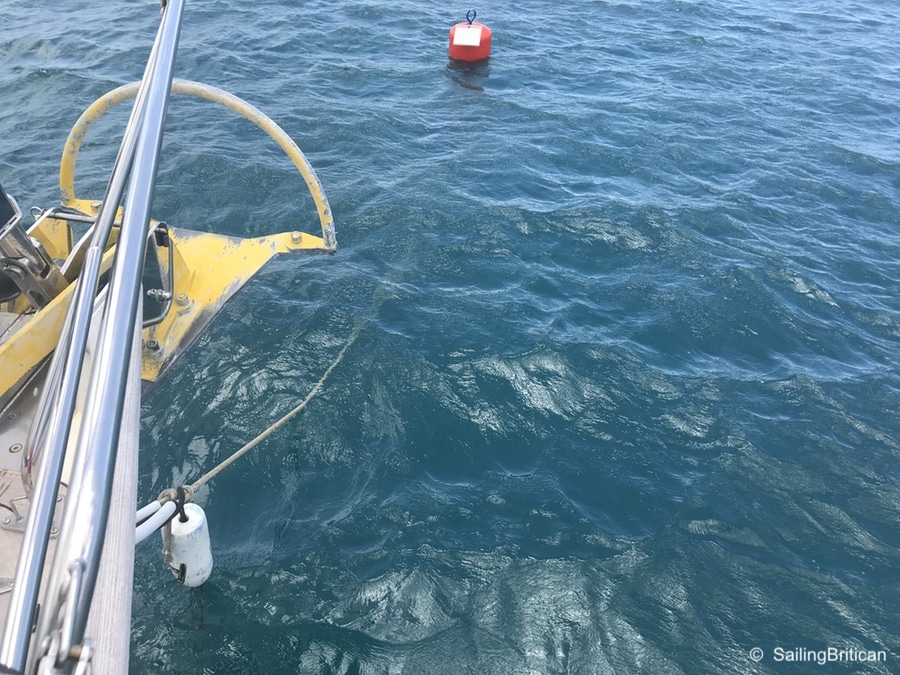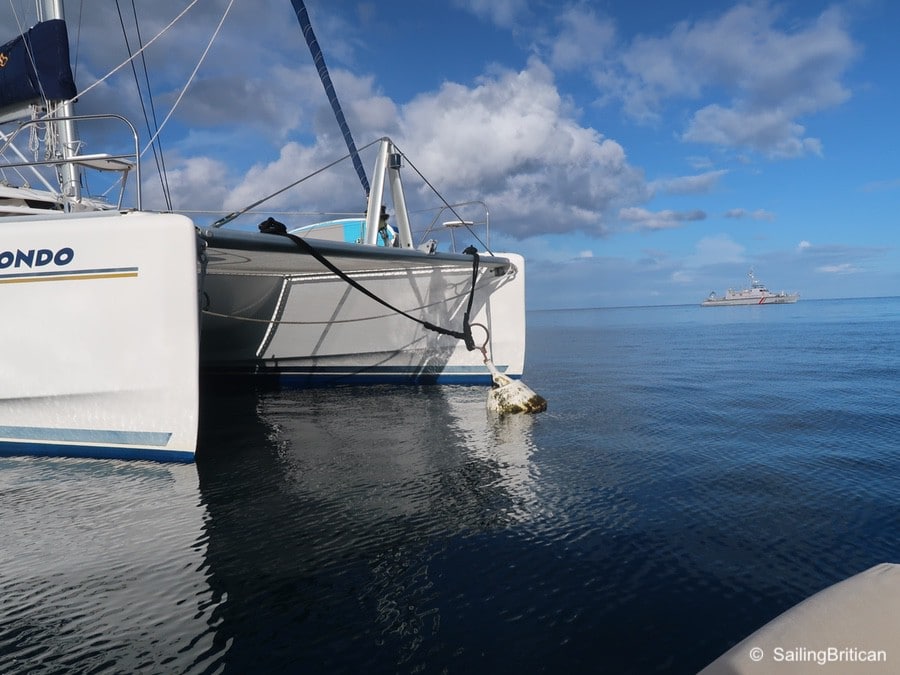In this video, I’ll show you how to easily tie onto a mooring ball (otherwise known as a mooring buoy), how to release the lines and leave a mooring ball, and, in the end, a little-known technique for preventing a mooring ball from hitting your hull (making a disturbing noise and damaging your paint job).
The key thing to stress is that I will make this ‘how-to’ process look easy.
I’ve done it thousands of times. When you’re new, it’s not so easy. Once you understand the concept, get out and practice. Practice, practice, and practice. Below the video, you’ll also find ten tips to avoid making mistakes with mooring balls. Make sure to also get a copy of my guide, Anchoring A Boat Made Easy: The Stress-Free Guide to Anchoring & Mooring.
And before watching the video, a common questions we are asked is about mooring ball cost. It really does vary, but an average is around $30. We have seen costs as high as $300/night and some as low is $0. The best way to get information on current costings is to contact other cruisers who are already in the area you’re heading to. Okay – let’s get on with the video and checklist below.
How To – Mooring Ball & Mooring Buoy Video
10 Tips to Avoid Making Mistakes with Mooring Balls
When you’re in a car and accidentally drive over a curb or make a mess of parallel parking, there are usually only a few people watching. When picking up a mooring ball, however, there might be times when you have a full bay of onlookers.
What’s important to keep in mind is that everyone makes mistakes.
Seasoned sailors put in several hours to get things right, even with loads of experience that still doesn’t guarantee a 100% success rate.
If you’re new to mooring balls, enter a mooring field when most boaters have already left for the day or get in before the rush. Also, spend time in a mooring field and watch others learn what to do and not do. Additionally, consider the following ten tips.

10 Tips For Mooring Ball / Mooring Buoy
1. Communications
We often position a third person midway between the Helmsperson and the Deckhand to help with communications (when we have a third person!). We’ve also seen other couples that use hands-free headsets to provide instructions to each other. Within the cruising community, they’ve been aptly named ‘marriage savers’ as they reduce the shouting that happens without them.
2. Redundancy
Always use at least two lines for redundancy purposes. Lines can easily chaff, and by having two lines affixed, the chances of coming unhooked are drastically reduced. Furthermore, if you use only one line, chances are that another boater will visit you and ask for you to add another line – especially if you’re lined up to hit them if you break free. And never run both lines through the mooring ball from one side and up to the other; doing so will set you up for serious chaffing issues.
3. Standards?
There is no local or international standard for mooring balls. One bay will have balls with long ropes and easy-to-lift pennants, and others will have heavy balls with only a metal ring at the top. Sometimes, it’s impossible to pull the ball up to the deck to tie a line on. When that happens, you can make a very large loop with one of your lines, throw it around the whole ball, and tie the line back to the boat. Make sure that the wind and/or current keep the line tight, and then drop your dingy to affix the lines to the ring on the ball. Once one line is secured, remove it around the whole ball and properly feed it through the hoop.
4. Directions
Note that some mooring balls have floats near the end or in the middle of the line that must be picked up. Often these floats are a bit of a distance from the actual mooring ball. The Deckhand needs to direct the Helmsperson to a position where the floating rope can be picked up rather than on the mooring ball.

5. Taking A Different Approach
Backing up to a mooring ball can be advantageous instead of going bow first. The same setup and directions apply. However, the lines are tied to the stern cleats of the boat. It can be easier for the Helmsperson to see the ball, and it may be simpler for the Deckhand to grab the ball pennant line out of the water simply. Care needs to be taken concerning any ropes getting caught in the prop, and the Deckhand should be careful not to fall in the water. An added benefit of picking up a mooring ball from the stern is that the wind will blow through the cabin providing more fresh air down below decks. You can also back up to a ball and walk the line to the boat’s bow.
6. No Wind Is Not Good
In no-wind situations, it’s very common for boats to swing randomly. When this happens, there’s a possibility of collision. In other words, it’s possible for two boats to actually swing into each other – especially if there’s a monohull next to a catamaran (they swing differently). When this happens, you can leave the mooring field or sleep in the cockpit, keeping one eye open. If boats hit each other, it’s often just a little kiss, but once, our bow hooked up with the bow of a catamaran and locked together! It took us a while to break the bond (the two boats were in love).
7. Making Things Easier
When leaving a mooring ball, there’s often a situation where the Deckhand cannot get the line untied from the cleat or pulled through the eyelet due to tension. If this is the case, the Helmsperson needs to engage the engine to get closer to the mooring ball. By engaging the engine, slack will be created in the line making the line easier to untie.
8. No-No To Bow Thrusters
Don’t use bow thrusters if a line or a mooring ball pendant is possibly in the water when tying onto a mooring ball.
9. Stay At Your Station
The Helmsperson should NEVER leave the helm if the Deckhand is having difficulty. It’s far easier to let the line go and try again than for the Helmsperson to rush back to the wheel to avoid a collision. The Deckhand needs to be prepared to drop the line if need be. It’s much better to circle than get rope burns, cuts, or bruises. Inexperienced crewmembers can, from time to time, get the hook stuck in the mooring ball, which could result in the loss of the hook. It’s something to be careful with. If possible, make sure your hook can float; it might be worth having a spare.
10. A Little Help
If help is provided in a mooring field, someone on a boat will approach the bow. This is how to tie to a mooring ball with assistance: Hand the bulk of the rope (coiled) and the end of the line to the person, and they will feed it through the mooring ball attachment giving it back to you to secure back on the same side. When grabbing the first rope back, you can often give the helper the coil and end of the other rope or position it in a place for them to grab it off the deck. In some parts of the world, the help comes for free; in others, there is a fee. We almost always accept help with mooring balls – for the small price you pay, it makes mooring much easier and often provides a much-needed income to locals.

And It’s Not Just Mooring Balls You Need To Know About
Newbie boat owners make a disaster out of mooring balls AND anchoring. We’ve met so many new sailors with the wrong anchor – one that is too small for the boat and doesn’t hold, OR it’s old technology and doesn’t work well. We’ve also witnessed most newbies with a terrible technique. You don’t simply drop the anchor when anchoring and then think your job is done!
Purchase my Checklists for Sailors to get everything you need to know about owning, maintaining, and sailing your boat.
Check Out Other Sailing, Maneuvering & Mooring Related Articles and Videos
To get an overview of all our sailing, maneuvering, and mooring-related articles and videos, start here: Sailing, Maneuvering & Mooring. Otherwise, check out one of these articles or videos:
- Stern To Med Mooring
- High Wind Sailing Techniques
- How To Tie Onto A Mooring Ball
- How To Leave A Dock
- Anchoring In Poor Holding Anchorages
- Anchoring In Storms
- Sailing Through A Storm
Get REAL EXPERIENCE Tying Up to a Mooring Ball!
Spend a week with Simon, and you’ll practice so often that when you’re ready to do it in your boat, you’ll look like a professional from day one. More information here: Sailing Lifestyle Experiences (previously called the Britican Experience). Also, check out the great selection of Sailing books on Amazon.com



09.10.2019
Hi everyone !
Your mooring ball footage was very nicely done -great attention to detail – attracts
the eye ball & stays in the mind! Well done! It’s especially important to note current state of the mooring ball rig & any rotting floating line attached if their line doesn’t hold the boat it won’t make any difference how many of your mooring lines are in the eyelet!
W.W. Happy Sailing